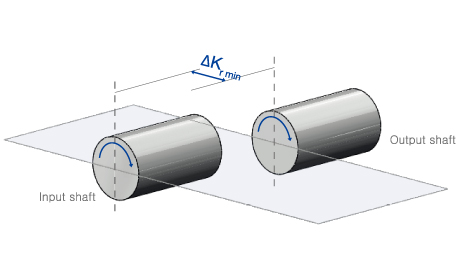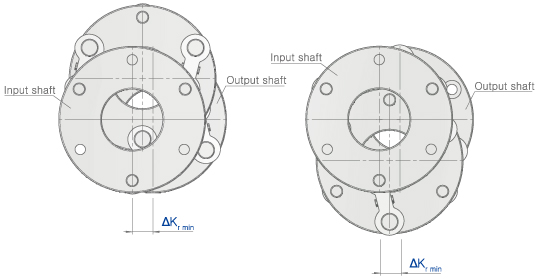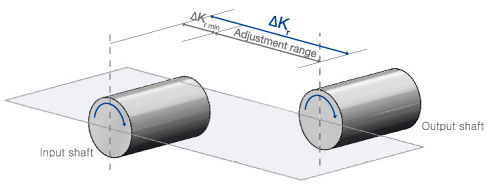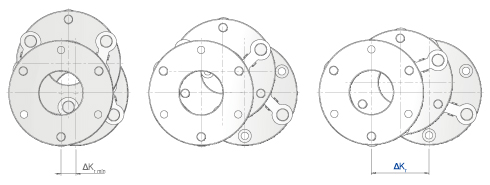Radial offset
The Schmidt-Kupplung coupling can be radially offset within the relevant pivoting range. Please note the limits specified in the tables of values for maximum allowable offset, maximum displacement and minimum required offset. Compliance with these values ensures that the shafts of the coupling do not run in an inadmissible alignment or in extended position.
Minimal Radial Offset △Kr min
The coupling may not operate in alignment position Kr=0. In alignment position, the center disc would have no definite position in space but would be stimulated to its own movement. Therefore, a minimal required radial offset △Kr min must be provided for both shafts to be connected. To this end, the output shaft must be moved horizontally (Figure 1) or vertically to achieve this minimum offset.
The figure below illustrates the installation position of the coupling when selecting △Kr min in the lateral, horizontal direction. The center disc can be located above (Figure 2a) or below (Figure 2b).
For the relevant value of the minimum required radial offset △Kr min for a coupling size, please refer to the technical data.

direction to achieve the minimum required radial
offset

in horizontal direction
Maximum Radial Offset △Kr
The Schmidt-Kupplung coupling is a compactly built coupling for precise torque transmission of extremely radially offset shafts. The height of the maximum permissible radial displacement is dependent on the length/depth gauge of the coupling elements used for the relevant coupling size.
The maximum permissible radial offset results from the sum △Kr min and the adjustment range (Figure 3). For the relevant value of the maximum permissible radial offset △Kr for a coupling size, please refer to the technical data.
Figure 4 shows the path of the centre disc of the Schmidt-Kupplung coupling with adjusting movements starting at △Kr min to △Kr. Here, the center disc moves on a circular portion defined by the length/pitches of the coupling elements and thus always has a definite position.
To determine the exact position of the center disc for required installation space our application engineers will be pleased to assist you.


starting at △Kr min to △Kr
Maximum Linear Range of Coupling △Kv

Two installation situations are not permitted
- Inadmissible alignment
The coupling may not operate in alignment position Kr=0 (recognizable in that the coupling elements of link level 1 are parallel to the coupling elements in level 2). In alignment position, the center disc would have no definite position in space but would be stimulated to its own movement. For this reason, the aforementioned minimum required radial offset must be provided for every Schmidt-Kupplung coupling. - Inadmissible extended position
The coupling may not operate in extended position (recognizable in that the coupling elements of link level 1 are parallel to the coupling elements in level 2).


